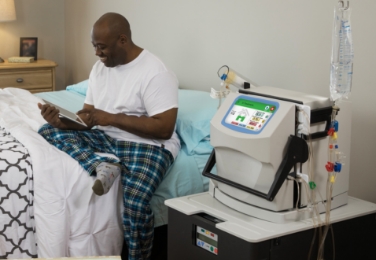- More Frequent Home Hemodialysis (HHD)
- Peritoneal Dialysis (PD)
Home Hemodialysis Customer Support: 866-697-8243
Peritoneal Dialysis Customer Support: 800-323-5188
Talk to a Patient Consultant About Home Dialysis: 888-200-6456
Home Hemodialysis Customer Support: 866-697-8243
Peritoneal Dialysis Customer Support: 800-323-5188
Talk to a Patient Consultant About Home Dialysis: 888-200-6456
Home Hemodialysis Customer Support: 866-697-8243
Peritoneal Dialysis Customer Support: 800-323-5188
Talk to a Patient Consultant About Home Dialysis: 888-200-6456
Home Hemodialysis Customer Support: 866-697-8243
Peritoneal Dialysis Customer Support: 800-323-5188
Talk to a Patient Consultant About Home Dialysis: 888-200-6456
The Benefits of More Frequent Home Dialysis
At Fresenius Medical Care, we’ve seen first-hand how patients have enjoyed improved health and a better quality of life through more frequent home dialysis whether home hemodialysis or peritoneal dialysis. But don’t take our word for it. Many studies have shown that the benefits of home dialysis go far beyond convenience.
Home Hemodialysis (HHD) & Peritoneal Dialysis (PD)
TREATMENT IN THE COMFORT OF YOUR HOME DURING THE DAY OR OVERNIGHT.
Hemodialysis involves accessing your blood through an access site. Most access sites are located in the lower arm but can also be located in the upper chest or leg. The dialysis procedure involves cleaning your blood through a special filter on a dialysis machine.
HHD follows a similar treatment procedure as in-center hemodialysis but is usually done in the comfort of your home, and more frequently, 5 or 6 days a week. More frequent hemodialysis may lead to improved health and quality of life outcomes compared to traditional 3 times per week in-center therapy. HHD can be performed during the day with or without a care partner (solo/independent) or overnight while you and your care partner sleep (nocturnal). A care partner is not a medical professional and can be a friend, spouse, colleague, or family member.
When treating at home, patients are not constrained by the schedule of a dialysis center, and physicians have more flexibility to tailor dialysis prescriptions to patients’ individual clinical and quality of life needs. Most patients who do hemodialysis at home perform their treatment more frequently than in-center patients.
1. Daugirdas, John T.; Blake, Peter G.; and Ing, Todd S., “Handbook of Dialysis (5th ed.)” (2015).
TREATMENT YOU CAN DO ALMOST ANYWHERE.
PD uses a membrane inside your abdomen as a filter to remove toxins and extra fluid from your blood. Typically, PD patients can perform therapy on their own-at home or almost anywhere. PD treatments are done daily, so waste and toxins in your blood don’t have a chance to build up as much between treatments. PD may lead to enhanced health and quality of life outcomes vs 3 times weekly in-center hemodialysis.
There are two types of peritoneal dialysis: continuous ambulatory peritoneal dialysis (CAPD) and automated peritoneal dialysis (APD).
CONTINUOUS AMBULATORY PERITONEAL DIALYSIS (CAPD):
This type uses a disposable double bag system. The patient performs manual exchanges which take around 20-30 minutes to complete, and are usually done 3-5 times per day. After a CAPD exchange is started, most people read, watch TV, or use their computer for 20-25 minutes during drain and fill. Between exchanges, normal activities can resume while the fluid dwells.
AUTOMATED PERITONEAL DIALYSIS (APD):
APD includes several modality types. Typically, the patient sets up the cycler at bedtime and the machine performs the exchanges while they are sleeping. In the morning, the cycler can leave the patient dry or do a Last Fill that allows the patient to also dwell during the day. Once disconnected, normal activities are resumed.
1. Daugirdas, John T.; Blake, Peter G.; and Ing, Todd S., “Handbook of Dialysis (5th ed.)” (2015).
Live Healthier and Better
Patients report and studies show numerous clinical and lifestyle benefits associated with more frequent home dialysis when compared to conventional, three times per week, in-center hemodialysis.
Talk to a Patient Consultant
Complete the form to learn more about the benefits of more frequent home dialysis.
Risks and Responsibilities
The reported benefits of peritoneal dialysis may not be experienced by all patients.
Peritoneal dialysis does involve some risks that may be related to the patient, center, or equipment. These include, but are not limited to, infectious complications. Examples of infectious complications include peritonitis and exit-site and tunnel infections. Non-infectious complications include catheter complication such as migration and obstruction, peritoneal leaks, constipation, hemoperitoneum, hydrothorax, increased intraperitoneal volume, and respiratory and gastric issues. It is important for healthcare providers to monitor patient prescriptions and achievement of adequate fluid management goals.
Patients should consult their doctor to understand the risks and responsibilities of performing peritoneal dialysis.
Patients should review the following information carefully and discuss it with their doctors to decide whether home hemodialysis with NxStage systems is right for them.
Users should weigh the risks and benefits of performing home hemodialysis with NxStage systems.
- Medical staff will not be present to respond to health emergencies that might happen during home treatments, including, among other things, dizziness, nausea, low blood pressure, and fluid or blood leaks.
- Users may not experience the reported benefits of home, more frequent, or nocturnal hemodialysis with the NxStage systems.
- The NxStage systems require a prescription for use.
Users will be responsible for all aspects of their hemodialysis treatment from start to finish.
- Medical staff will not be present to perform home treatments. Users will be responsible for, among other things, equipment setup, needle insertions, responding to and resolving system alarms, system tear-down after treatment, monitoring blood pressure, ensuring proper aseptic technique is followed, and following all the training material and instructions that nurses provide.
Users will need additional resources to perform home hemodialysis.
- Users will need a trained care partner to be present during your treatment at home (unless their doctor prescribes “solo/independent” home hemodialysis, described below).
- Users must have a clean and safe environment for their home treatments.
- Users will need space in their home for boxes of supplies necessary to perform home hemodialysis with NxStage systems.
Certain forms of home hemodialysis have additional risks.
- If a doctor prescribes home hemodialysis more than 3 times a week, vascular access is exposed to more frequent use which may lead to access related complications, including infection of the site. Doctors should evaluate the medical necessity of more frequent treatments and discuss the risks and benefits of more frequent therapy with users.
- If a doctor prescribes “solo/independent” home hemodialysis without a care partner during waking hours, risks of significant injury or death increase because no one is present to help users respond to health emergencies. If users experience needles coming out, blood loss, or very low blood pressure during solo/independent home hemodialysis, they may lose consciousness or become physically unable to correct the health emergency. Users will need additional ancillary devices and training to perform solo/independent home hemodialysis.
- If a doctor prescribes “nocturnal” home hemodialysis at night while the user and a care partner are sleeping, risks increase due to the length of treatment time and because therapy is performed while the user and a care partner are sleeping. These risks include, among other things, blood access disconnects and blood loss during sleep, blood clotting due to slower blood flow or increased treatment time or both, and delayed response to alarms when waking from sleep. A doctor may need to adjust users’ medications for nocturnal home hemodialysis, including, among other things, iron, Erythropoiesis-Stimulating Agents (ESA), insulin/oral hypoglycemics, anticoagulants, and phosphate binders.
REFERENCES
- The FHN Trial Group. In-center hemodialysis six times per week versus three times per week. N Engl J Med. 2010;363(24):2287-2300.
- Rocco MV, Lockridge RS, Beck GJ, et al. The effects of frequent nocturnal home hemodialysis: the Frequent Hemodialysis Network Nocturnal Trial. Kidney Int.
- U.S. Renal Data System, USRDS 2015 Annual Data Report: Table 6.3.
- U.S. Renal Data System, USRDS 2015 Annual Data Report: Table 6.3. and matched NxStage patient data on file.
- Bakris, G.L., Burkart, J.M., Weinhandl, E.D., McCullough, P.A., and Kraus, M.A. Intensive hemodialysis, blood pressure, and antihypertensive medication use. Am J Kidney Dis. 2016; 68: S15–S23.
- Finkelstein FO, Schiller B, Daoui R, et al. At-home short daily hemodialysis improves the long-term health-related quality of life. Kidney Int. 2012;82(5): 561-569.
- Weinhandl ED, Liu J, Gilbertson DT, Arneson TJ, Collins AJ. Survival in daily home hemodialysis and matched thrice-weekly in-center hemodialysis patients. JASN. 2012;23(5):895-904.
- Lerma EV, Weir MR. Henrich’s Principles and Practice of Dialysis. Chapter 8: Long and Daily Hemodialysis, 2017. Print.
- Purnell TS, Auguste P, Crews DC, et al. Comparison of Life Participation Activities Among Adults Treated by Hemodialysis, Peritoneal Dialysis, and Kidney Transplantation: A Systematic Review. Am J Kidney Dis. 2013;62(5):953-973.
- Walker RC, Howard K, Morton RL. Home hemodialysis: a comprehensive review of patient-centered and economic considerations. Clinicoecon Outcomes Res. 2017;9:149-161.
- Jaber BL, Lee Y, Collins AJ, et al. Effect of daily hemodialysis on depressive symptoms and post-dialysis recovery time: interim report from the FREEDOM (Following Rehabilitation, Economics and Everyday-Dialysis Outcome Measurements) Study. Am J Kidney Dis. 2010;56(3):531-539.
- Rayner HC, Zepel L, Fuller DS, et al. Recovery time, quality of life, and mortality in hemodialysis patients: the Dialysis Outcomes and Practice Patterns Study (DOPPS). Am J Kidney Dis. 2014;64(1):86-94.
- Jaber, B.L., Schiller, B., Burkart, J.M. et al, Impact of short daily hemodialysis on restless legs symptoms and sleep disturbances. Clin J Am Soc Nephrol. 2011;(6):1049–1056.
APM2093 Rev. J
Our Offices
350 Merrimack Street
Lawrence, MA 01843
United States
350 Merrimack Street
Lawrence, MA 01843
United States
920 Winter Street
Waltham, MA 02451
United States
920 Winter Street
Waltham, MA 02451
United States
1-866-NxStage (697-8243)
1-866-NxStage (697-8243)
© 2025 Fresenius Medical Care. All Rights Reserved.
© 2025 Fresenius Medical Care. All Rights Reserved.








